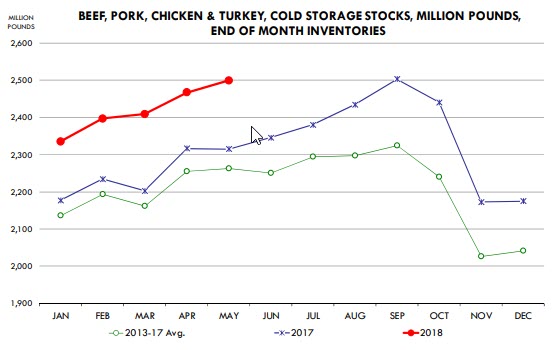Trade disruptions may lead to further increases in meat stocks
By Kaitlynn Anderson
Staff Writer
Farms.com
The U.S. could face a red meat and poultry supply issue if the country’s frozen inventories continue to rise.
The United States had 2.499 billion pounds of frozen beef, pork, chicken and turkey in cold storage as of May 31, the USDA’s most recent Cold Storage report shows. Pork products accounted for 621.736 million pounds of this total.
The red meat and poultry inventories increased 8 percent from the May 2017 stocks and are 10.5 percent higher than the country’s five-year average, analysts at the Steiner Consulting Group, an economic consulting company in New Hampshire, revealed in their Daily Livestock Report yesterday.
“This volume is only slightly lower than the all-time record established last fall,” the experts said.
And the current supply could continue to grow.
“Normally, freezer stocks move up between now and September,” the analysts said.

Source: Daily Livestock Report, June 25, 2018
In the pork sector specifically, the U.S. saw an above-average increase in the supply of hams in cold storage.
Weighing in at 139.2 million pounds at the end of May, the inventory increased by 24 percent over the previous month, the report said. (Over the past five years, the average increase for this period was 21 percent.)
If trade disruptions occur between Mexico and the U.S., ham inventories could increase even further, the analysts warned.
Trade challenges with other markets could also have negative effects.
The U.S. exported around 1,000 metric tons (MT) of pork to China per week in March, the report said. In May, this amount fell to 300 MT per week. Last week, American exporters didn’t ship any pork to Chinese markets.
Experts fear that the meat and poultry industries could face more challenges in the future.
“The effect of tariffs on U.S. pork has only started to be felt and will only get worse from here,” the analysts said in the report.
Evgeniy1/iStock/Getty Images Plus photo